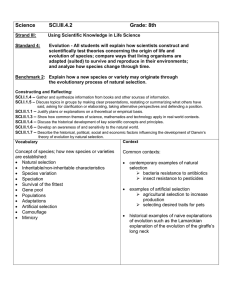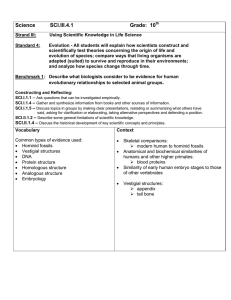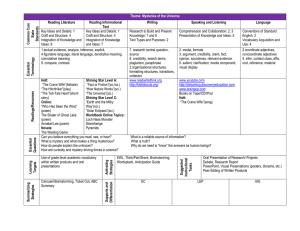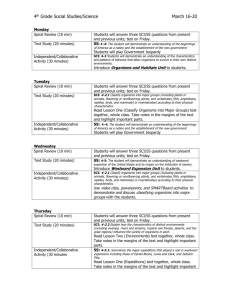Science SCI.III.4.2
advertisement
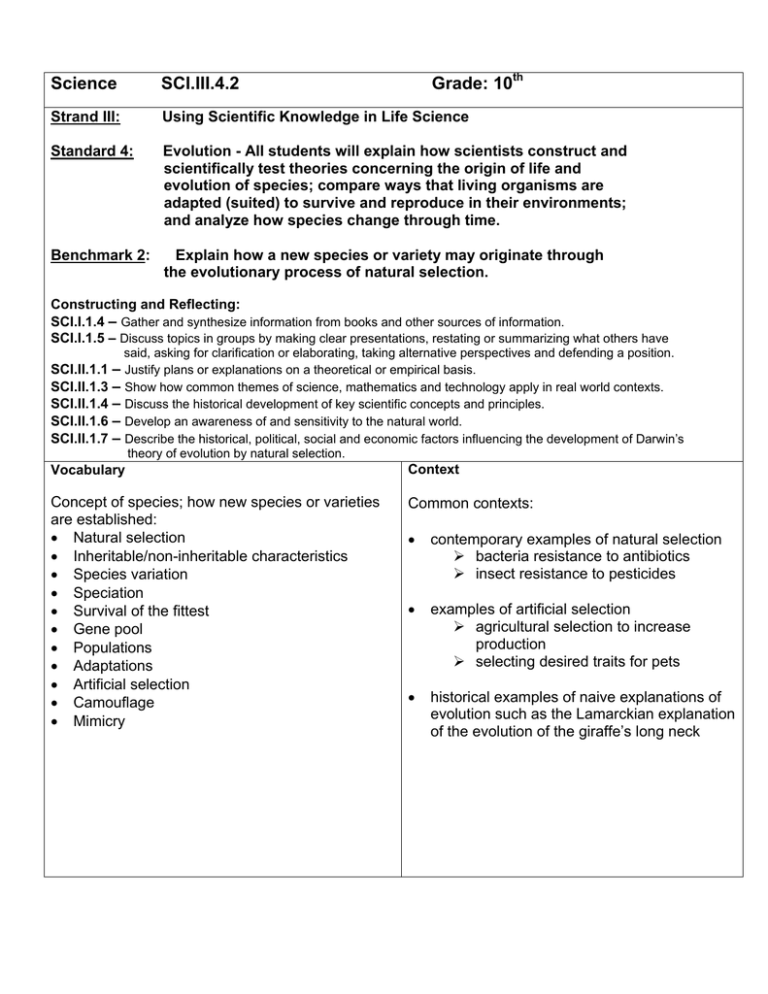
Grade: 10th Science SCI.III.4.2 Strand III: Using Scientific Knowledge in Life Science Standard 4: Evolution - All students will explain how scientists construct and scientifically test theories concerning the origin of life and evolution of species; compare ways that living organisms are adapted (suited) to survive and reproduce in their environments; and analyze how species change through time. Benchmark 2: Explain how a new species or variety may originate through the evolutionary process of natural selection. Constructing and Reflecting: SCI.I.1.4 – Gather and synthesize information from books and other sources of information. SCI.I.1.5 – Discuss topics in groups by making clear presentations, restating or summarizing what others have SCI.II.1.1 – SCI.II.1.3 – SCI.II.1.4 – SCI.II.1.6 – SCI.II.1.7 – said, asking for clarification or elaborating, taking alternative perspectives and defending a position. Justify plans or explanations on a theoretical or empirical basis. Show how common themes of science, mathematics and technology apply in real world contexts. Discuss the historical development of key scientific concepts and principles. Develop an awareness of and sensitivity to the natural world. Describe the historical, political, social and economic factors influencing the development of Darwin’s theory of evolution by natural selection. Vocabulary Context Concept of species; how new species or varieties are established: • Natural selection • Inheritable/non-inheritable characteristics • Species variation • Speciation • Survival of the fittest • Gene pool • Populations • Adaptations • Artificial selection • Camouflage • Mimicry Common contexts: • contemporary examples of natural selection ¾ bacteria resistance to antibiotics ¾ insect resistance to pesticides • examples of artificial selection ¾ agricultural selection to increase production ¾ selecting desired traits for pets • historical examples of naive explanations of evolution such as the Lamarckian explanation of the evolution of the giraffe’s long neck Knowledge and Skills Students will: • Describe how changes within the environment affect the survival and reproduction of certain individuals. • Resources Coloma Resources: www.dbol.glenco.com Glenco Biology Text – CH 15 Predict how the selection for specific traits might result in the development of a new species. • Relate natural selection to the development of new populations (e.g. a strain of bacteria becoming resistant) Other Resources: • Evolution and the Nature of Science Institute Excellent site with units and lessons dedicated to The Nature of Science, Evolution, The Origin of Life and DNA. • Identify the differences between inherited and non-inherited traits • Brain POP Movies • • Scope Unit – Taxonomy of Evolution Michigan Teacher Network – 14 resources for this benchmark • Howard Hughes Medical Institute – incredible free resources • http://www.thirteen.org/wnetschool/origlesson s/evolution/ “Scopes monkey trial” Videoconferences Available For more information, see www.remc11.k12.mi.us/dl or call Janine Lim 4717725x101 or email jlim@remc1.k12.mi.us III.4.HS.2 Animal Adaptations from the Toledo Zoo Instruction • Assessment Optional Assessment Grow bacterial colonies on agar plates containing 0.5% concentration of antiseptic Constructed response question: (Lysol). Transfer surviving bacteria to • Suppose that an earthquake separates Michigan increasingly more concentrated antiseptic from its surrounding states preventing animals agar. When maximum concentration is from living together. The common deer reached (about 15%), then some of the population that lives in Michigan and in the once original stock colony (0%) will be surrounding states can no longer live together and transferred directly to another plate with the mate. Explain how, through time, two different highest concentration (15%). Growth on species of deer may evolve from the common the two plates with the highest ancestor, the white-tailed deer common in concentration will be analyzed. Develop an Michigan now that there are two separate explanation for the difference between the populations. Corresponds to standard II.1.5. two plates. (A new population has (Evaluation rubric in MI-CLiMB) developed through natural selection when the surviving bacteria was transferred from Criteria Apprentice Basic Meets Exceeds plate to plate of increasing concentration.) CorrectAnswers with Answers Answers Answers Corresponds to standard I.1.2 ness of two correct with three with four with five responses **Only use purchased bacteria that are acceptable for classroom use. responses. correct correct correct responses responses responses Teacher Notes: Focus Question: How are new populations developed through natural selection? Explain how scientists construct and scientifically test theories concerning the origin of life and evolution of species. Are there patterns of similarity among organisms alive today? Are there relationships among organisms that lived in the past and organisms alive today? Where did humans come from in the history of the world? What is the evidence that might give us some clues to these questions? Many students come to the science classroom with strongly held beliefs that don't allow them to openly examine the scientific explanations to these questions. The challenge in the science classroom is to help students distinguish between a scientist's way of thinking and understanding from those practiced by some theologians, poets, or philosophers. Students need working definitions of key terms with clear examples to provide a framework for their thinking. This should help them demarcate where science begins and ends. Words such as fact, theory, hypothesis, and law are terms students encounter in casual conversation in everyday life. In science these terms have a very specific meaning. A fact is an observation that has been repeatedly confirmed but facts can change. It was a scientific fact for many years that human cells had 24 pairs of chromosomes. Improved techniques of microscopy revealed that they actually have 23 pairs. People commonly use the word theory to mean a "guess" or "hunch". "My theory is..." in common usage would be better stated as "My hypothesis is....". In science, a hypothesis is a testable statement about the natural world. A theory, in science, is a well-substantiated explanation of some aspect of the natural world. It is a powerful idea that represents our best explanation at this time. The abundance of supporting evidence makes the subsequent abandonment of a theory unlikely. Theories can be continually refined and even replaced with an alternative theory in light of new and compelling evidence. Finally, laws are generalizations that describe phenomena whereas theories explain phenomena. The laws of thermodynamics describe what will happen under certain circumstances; thermodynamic theories explain why these events occur. A clear understanding of these terms should provide students the structure needed to begin the study of evolution. It is important for students to be able to distinguish between evolution and the proposed mechanism, which accounts for its occurrence. Evolution is the historical change in life forms that is well substantiated and is generally accepted as fact by scientists. Students should explore the similarities of vertebrate's limb structures such as the forelimb of a chicken or bat, human, whale, cat, and lizard. They may also study similarities in the early development of vertebrate embryos. Students need an opportunity to observe, from the fossil record, kinds of organisms that once lived on earth but now are extinct such as the Petoskey stone's, Hexagonaria percarinata, trilobites, or crinoids. They can examine the apparent relatedness of fossils to one another and to organisms living today. This will begin to lay the groundwork for evidence of common ancestry. Students are naturally drawn to questions of their own ancestry. Students can perform a simple comparison for similarities and differences when given pictures or models of a gorilla, a modern human, and a hominid fossil skull. Patterns will emerge as students discover intermediate traits and forms. Further study of the relationships of humans to other selected animal groups can be done by looking at DNA and blood protein similarities. Vestigial structures such as the appendix, tailbone, wisdom teeth, and ear muscles also give evidence to common ancestry with selected animal groups. Patterns and evidence of change, as well as recognizing the diversity and apparent relatedness of species, needs to be firmly established before delving into possible mechanisms for evolution. To better understand natural selection students can survey the examples of artificial selection occurring today with common pets like cats and dogs, or numerous agricultural products.
